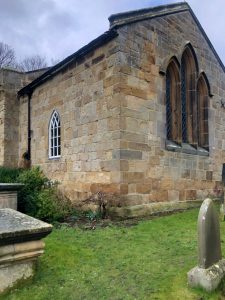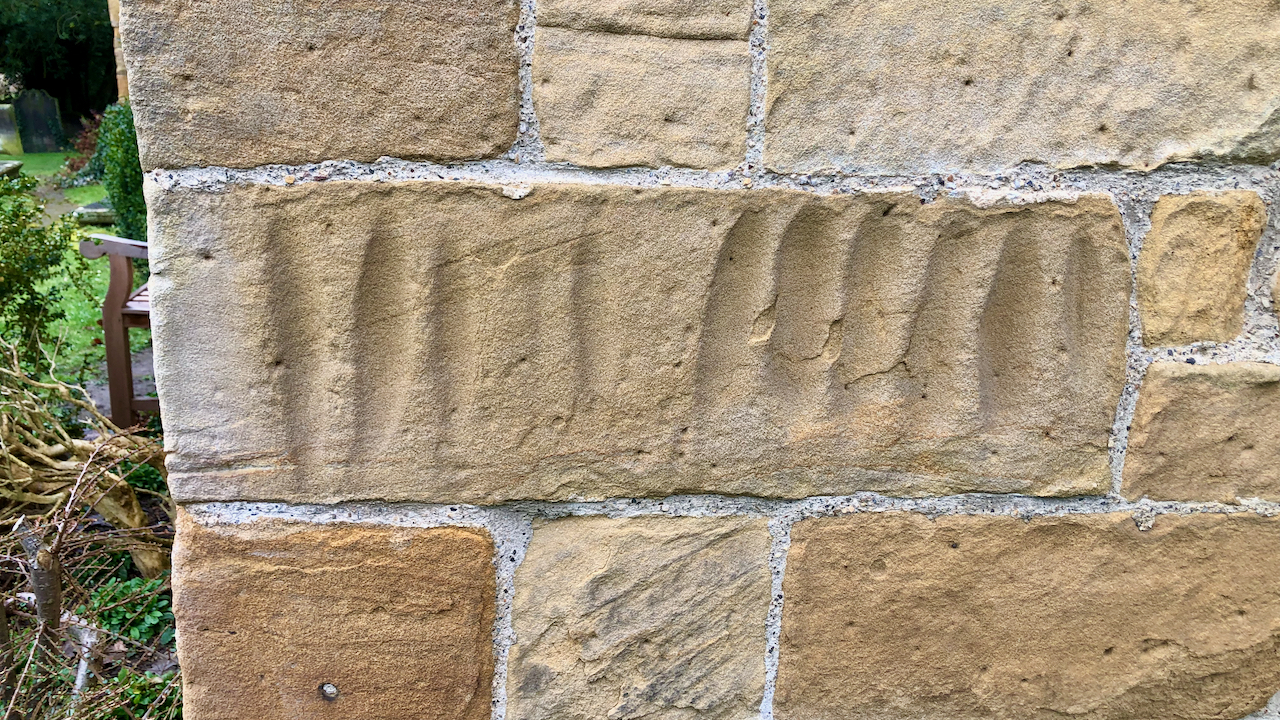
Not a day for photography on the moors. So a quick visit to the local church. All Saints Church, Great Ayton.
The present building dates from the 12th-century but an an Anglo Saxon church in the Domesday Book.
One curiosity is a series of groves incised on a quoin (cornerstone) of the gable to the chancel.
Many medieval churches have similiar features and the commonly held belief is that they were cut by archers sharpening the steel tip of their arrowheads before practice at the butts.
Edward III decreed in 1363 that “that every man should practise at the butts on Sundays and holidays, all other sports being forbidden”.
However, this myth has now been largely discredited1‘Mediaeval Mythbusting Blog #10: Arrow Stones – Triskele Heritage’. 2021. Triskele Heritage – Archaeology / Lectures / Publications / Broadcasting <https://triskeleheritage.triskelepublishing.com/mediaeval-mythbusting-blog-10-arrow-stones/> [accessed 27 February 2023].
In 1354-55, the Archbishop of York, John Thoresby, commanded that “no one in church, or porch, or cemetery, on Sundays & holy days, keep market or place of selling; let wrestlings, archery meetings, and games be forbidden therein“.
The name the Butts and Butt Lanes survive in many towns and villages indicating where archery was indeed practiced, In any case, churchyards were generally too small — in 1590, it was stated that an archer would routinely have to hit a target from 240-280 yards distant.
A ‘Toxophilius’ is a manual of archery and one dated 1545 stated that amongst the standard elements of an archer’s equipment would be portable whetstones for sharpening broadhead arrows — primarily used in hunting. However, as broadheads would have damaged the hempen butts, archers trained with rounded steel blunts made from horn, antler or wood, which did not need to be sharpened and in any case soft sandstone would have had a blunting rather than sharpening effect on an edge.
But what is the real reason for the grooves?
The current thinking is that stone dust and earth, taken from holy places, were used in potions intended to cure fevers.This practice is still actually being carried out in certain parts of Continental Europe and in Ireland, where there are traditions of childless women scraping a specific stone in the churchyard to use in folk medicines.
In the 7th century, Bede described the removal of ‘pulverem‘ or dust by pilgrims, from the place where King Oswald of Northumbria died. When his bones were washed at Bardney Abbey, dust was removed from the pavement where this was carried out. Similar occurences are described were St Alban and Bishop Haeddi died. The locations appear to have been venerated and were considered to have important physical properties.
Throughout the later medieval period, there are several records of pilgrims scraping stone saint’s tombs, mixing it with holy water and drinking the potion as cures for fever, dysentery and various infirmities.
- 1‘Mediaeval Mythbusting Blog #10: Arrow Stones – Triskele Heritage’. 2021. Triskele Heritage – Archaeology / Lectures / Publications / Broadcasting <https://triskeleheritage.triskelepublishing.com/mediaeval-mythbusting-blog-10-arrow-stones/> [accessed 27 February 2023]

Leave a Reply